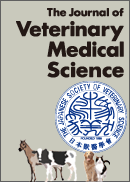Volume 81, Issue 12
December
Displaying 1-31 of 31 articles from this issue
- |<
- <
- 1
- >
- >|
Anatomy
-
2019 Volume 81 Issue 12 Pages 1692-1696
Published: 2019
Released on J-STAGE: December 18, 2019
Advance online publication: October 14, 2019Download PDF (3832K)
Bacteriology
-
2019 Volume 81 Issue 12 Pages 1769-1775
Published: 2019
Released on J-STAGE: December 26, 2019
Advance online publication: August 12, 2019Download PDF (1069K)
Ethology
-
2019 Volume 81 Issue 12 Pages 1829-1834
Published: 2019
Released on J-STAGE: December 26, 2019
Advance online publication: November 01, 2019Download PDF (1033K)
Immunology
-
2019 Volume 81 Issue 12 Pages 1776-1782
Published: 2019
Released on J-STAGE: December 26, 2019
Advance online publication: September 20, 2019Download PDF (1278K)
Internal Medicine
-
2019 Volume 81 Issue 12 Pages 1697-1704
Published: 2019
Released on J-STAGE: December 18, 2019
Advance online publication: October 10, 2019Download PDF (1394K) -
2019 Volume 81 Issue 12 Pages 1705-1712
Published: 2019
Released on J-STAGE: December 18, 2019
Advance online publication: October 09, 2019Download PDF (1095K) -
2019 Volume 81 Issue 12 Pages 1713-1721
Published: 2019
Released on J-STAGE: December 18, 2019
Advance online publication: October 15, 2019Download PDF (1681K) -
2019 Volume 81 Issue 12 Pages 1722-1729
Published: 2019
Released on J-STAGE: December 18, 2019
Advance online publication: October 22, 2019Download PDF (3740K) -
2019 Volume 81 Issue 12 Pages 1783-1790
Published: 2019
Released on J-STAGE: December 26, 2019
Advance online publication: October 15, 2019Download PDF (1031K) -
2019 Volume 81 Issue 12 Pages 1835-1841
Published: 2019
Released on J-STAGE: December 26, 2019
Advance online publication: November 05, 2019Download PDF (1773K) -
2019 Volume 81 Issue 12 Pages 1730-1734
Published: 2019
Released on J-STAGE: December 18, 2019
Advance online publication: October 15, 2019Download PDF (761K) -
2019 Volume 81 Issue 12 Pages 1842-1849
Published: 2019
Released on J-STAGE: December 26, 2019
Advance online publication: October 31, 2019Download PDF (1760K) -
2019 Volume 81 Issue 12 Pages 1850-1852
Published: 2019
Released on J-STAGE: December 26, 2019
Advance online publication: November 04, 2019Download PDF (1217K)
Laboratory Animal Science
-
2019 Volume 81 Issue 12 Pages 1735-1739
Published: 2019
Released on J-STAGE: December 18, 2019
Advance online publication: October 14, 2019Download PDF (1531K)
Parasitology
-
2019 Volume 81 Issue 12 Pages 1740-1748
Published: 2019
Released on J-STAGE: December 18, 2019
Advance online publication: October 15, 2019Download PDF (1377K) -
2019 Volume 81 Issue 12 Pages 1853-1858
Published: 2019
Released on J-STAGE: December 26, 2019
Advance online publication: November 19, 2019Download PDF (2305K)
Pathology
-
2019 Volume 81 Issue 12 Pages 1791-1803
Published: 2019
Released on J-STAGE: December 26, 2019
Advance online publication: October 10, 2019Download PDF (3700K) -
2019 Volume 81 Issue 12 Pages 1749-1752
Published: 2019
Released on J-STAGE: December 18, 2019
Advance online publication: October 23, 2019Download PDF (2297K) -
2019 Volume 81 Issue 12 Pages 1859-1862
Published: 2019
Released on J-STAGE: December 26, 2019
Advance online publication: October 24, 2019Download PDF (3209K) -
2019 Volume 81 Issue 12 Pages 1863-1867
Published: 2019
Released on J-STAGE: December 26, 2019
Advance online publication: October 28, 2019Download PDF (3577K)
Pharmacology
-
2019 Volume 81 Issue 12 Pages 1804-1809
Published: 2019
Released on J-STAGE: December 26, 2019
Advance online publication: October 14, 2019Download PDF (1004K) -
2019 Volume 81 Issue 12 Pages 1810-1816
Published: 2019
Released on J-STAGE: December 26, 2019
Advance online publication: October 22, 2019Download PDF (1816K)
Surgery
-
2019 Volume 81 Issue 12 Pages 1868-1872
Published: 2019
Released on J-STAGE: December 26, 2019
Advance online publication: October 22, 2019Download PDF (1354K)
Theriogenology
-
2019 Volume 81 Issue 12 Pages 1817-1823
Published: 2019
Released on J-STAGE: December 26, 2019
Advance online publication: October 31, 2019Download PDF (860K) -
2019 Volume 81 Issue 12 Pages 1873-1878
Published: 2019
Released on J-STAGE: December 26, 2019
Advance online publication: November 13, 2019Download PDF (1049K)
Virology
-
2019 Volume 81 Issue 12 Pages 1753-1762
Published: 2019
Released on J-STAGE: December 18, 2019
Advance online publication: October 28, 2019Download PDF (3285K) -
2019 Volume 81 Issue 12 Pages 1824-1828
Published: 2019
Released on J-STAGE: December 26, 2019
Advance online publication: September 27, 2019Download PDF (1063K) -
2019 Volume 81 Issue 12 Pages 1879-1886
Published: 2019
Released on J-STAGE: December 26, 2019
Advance online publication: November 07, 2019Download PDF (1869K) -
2019 Volume 81 Issue 12 Pages 1887-1891
Published: 2019
Released on J-STAGE: December 26, 2019
Advance online publication: November 05, 2019Download PDF (719K)
Wildlife Science
-
2019 Volume 81 Issue 12 Pages 1763-1768
Published: 2019
Released on J-STAGE: December 18, 2019
Advance online publication: September 24, 2019Download PDF (1983K) -
2019 Volume 81 Issue 12 Pages 1892-1895
Published: 2019
Released on J-STAGE: December 26, 2019
Advance online publication: November 04, 2019Download PDF (1323K)
- |<
- <
- 1
- >
- >|
